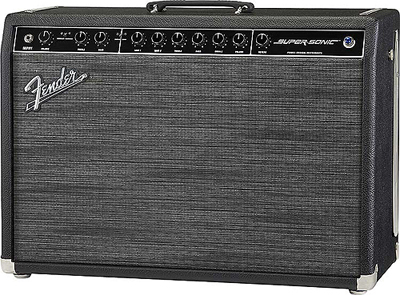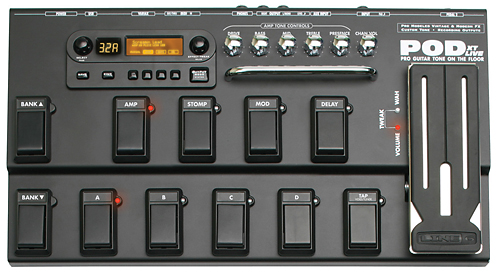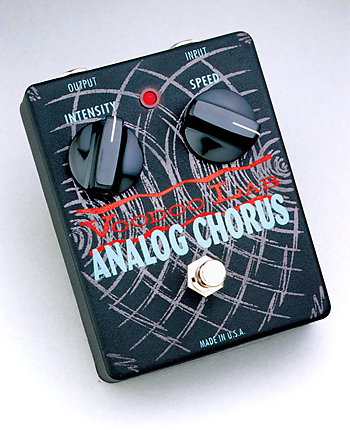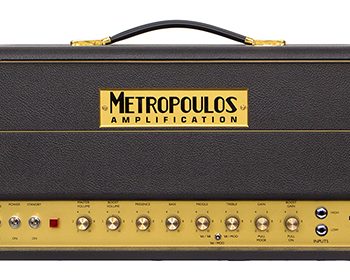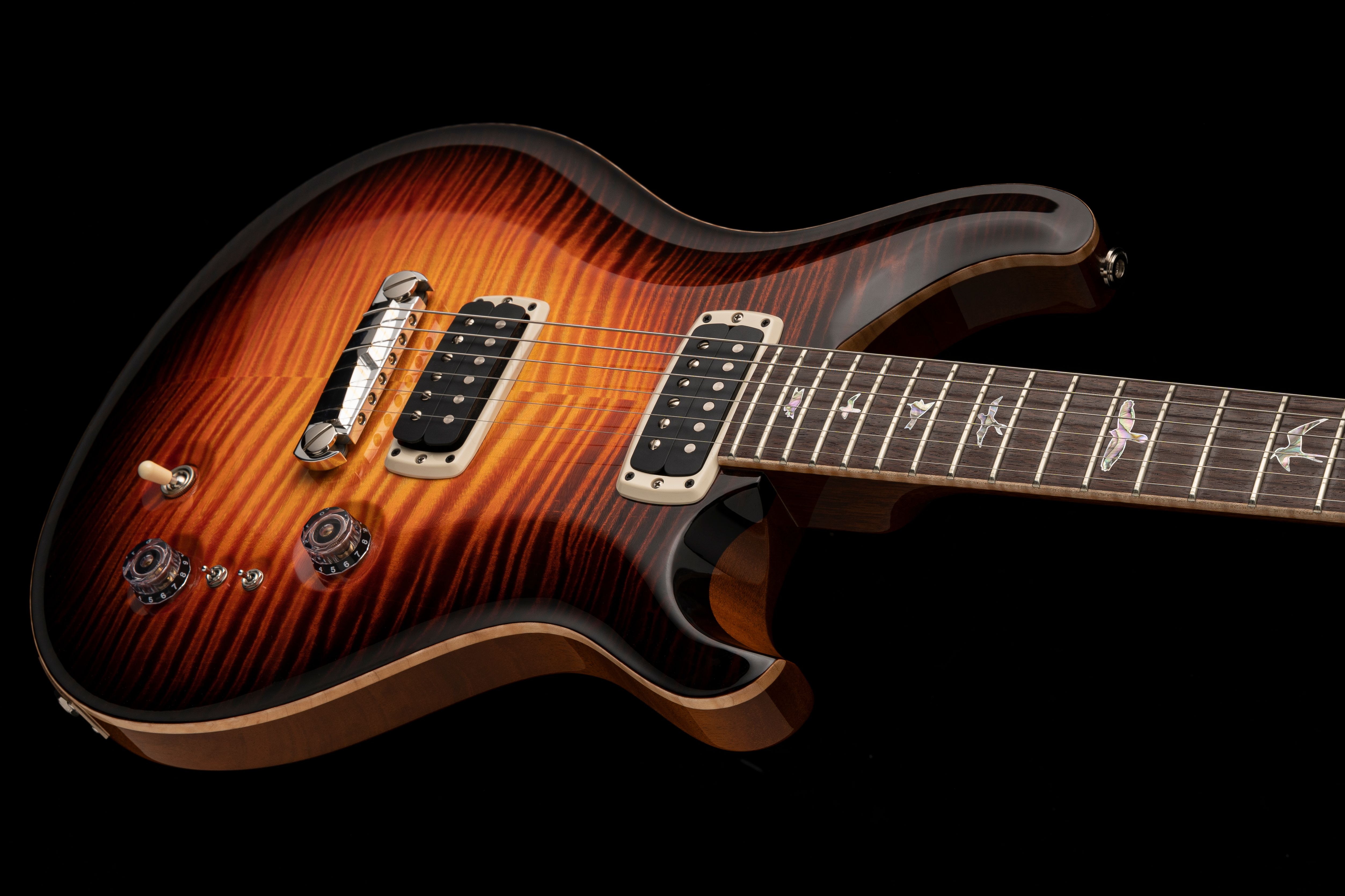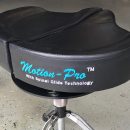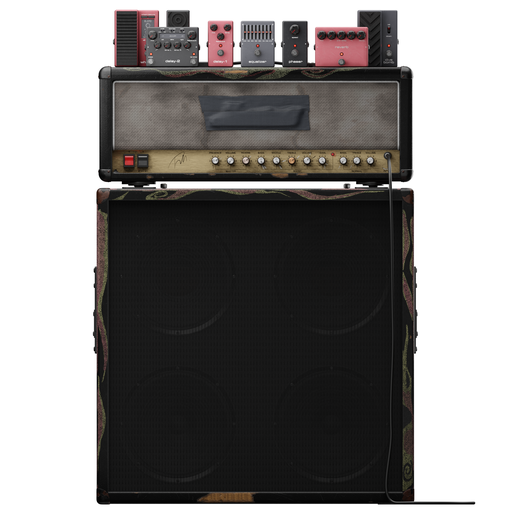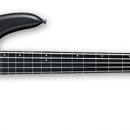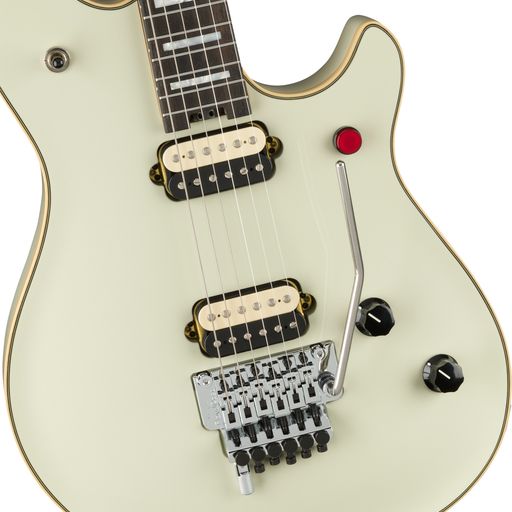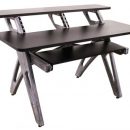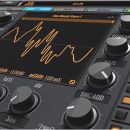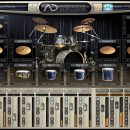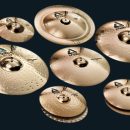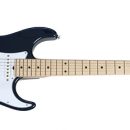 Some champions are born, while others are made. In the case of the new Fender Super-Sonic, this amp was born into a lineage of champions. Widely regarded for clean tones to die for, Fender amps have rarely been looked to for their overdrive and distortion tones. In fact, most Fender-playing guitar heroes routinely use one or more distortion, fuzz, or overdrive pedals in front of their amps to obtain their coveted tones.
Some champions are born, while others are made. In the case of the new Fender Super-Sonic, this amp was born into a lineage of champions. Widely regarded for clean tones to die for, Fender amps have rarely been looked to for their overdrive and distortion tones. In fact, most Fender-playing guitar heroes routinely use one or more distortion, fuzz, or overdrive pedals in front of their amps to obtain their coveted tones.
The Super-Sonic is a welcome and important addition to the Fender amplifier line that enters new territory previously untouched by the Fenders of old. While the Vintage channel features classic sparkling Fender cleans, the Burn channel delivers everything from Texas blues to beautiful American high-gain tube distortion – no pedals required, and it does so beautifully.
| Category | Value | Rating |
| Features | 20% | |
| Usability | 25% | |
| Sound | 25% | |
| Documentation & Support | 10% | |
| Price | 20% | |
| OVERALL RATING = 3.6, which earns it a WIHO award. 3.6 stars or better: Outstanding, WIHO Award 3 stars or better: Worth considering 2 stars or better: Suited to specific needs 1 star or less: Not recommended |
||
Don’t be misled by the diminutive stature of a 1x12 combo – this is not a bedroom practice amp. Not only did the Super-Sonic deliver its beautiful tone with gobs of volume, but also it didn’t break a sweat when driving a 4x12 cabinet.
The Super-Sonic is the amplifier that will win Fender many new fans and converts, including us! We loved it so much that we had to purchase one of these for our personal use, and expect to give it a good workout on a regular basis.
Features
The Fender Super-Sonic is a sixty-Watt, two-channel amp available in a head configuration or as a 1x12 combo. We tested the combo, which comes loaded with a Celestion Vintage 30 speaker.
The two configurations of this amp vary slightly from one another internally:
Head preamp: five 12AX7 and one12AT7 preamp tubes.
Combo preamp: six 12AX7 and two 12AT7 preamp tubes.
Each configuration has two 6L6 output tubes. The combo additionally features an Accutronics long-spring Reverb unit, surprisingly absent from the head version. We have to wonder about this omission since the amp is not specifically a rack-optimized piece of gear like some dedicated rack-mountable guitar preamps.
The Super-Sonic combo automatically adjusts speaker load between four or eight Ohms while the Super-Sonic head has user-selectable settings for four, eight, or sixteen ohms.
The remaining features are identical between models:
Two channels. The Vintage channel has two circuits voiced to provide the tonal characteristics of either a Fender Vibrolux or Bassman amp. The Burn channel features a new dual cascading gain stage capable of achieving high-gain distortion (and softer sounds, too).
The Vintage channel has a switch to select the voicing mode and simple Bass and Treble tone controls. The Burn channel has controls for Gain 1, Gain 2, Bass, Middle, and Treble. Each channel has its own volume control, and there is a single master Reverb level (on the combo).
The rear of the amp has ¼” connections for an effects loop (wired in series), accompanied by knobs for both Send and Return levels.
Additional rear-panel connections include Pre Amp Out and Power Amp In (for connecting a pair of Super-Sonics together), speaker jacks for the internal speaker and external extension cabinets, Power, Standby, and Foot Switch. Though common to most Fender amps, we prefer Standby switches in particular to be located on the face of amps for easy access (if not both switches).
The included footswitch connects via a supplied ¼” stereo cable and has controls for selecting between the Vintage channel’s two voicings, selecting between the Vintage and Burn channels, and turning the effects loop On/Off. The footswitch does not have any control over the Reverb, presumably because it is shared with the head version of the amp that doesn’t include any Reverb.
If you don’t have a need for an effects loop, one interesting trick with this amp is to connect a short cable directly from the Send to the Return jack, set the levels to taste, and the footswitch’s Effects On/Off switch can be used as a volume/solo boost.
Usability
The Super-Sonic was a breeze to operate. Controls for adjusting each channel were simple, and setting matching levels between the Vintage and Burn channels was made easy by including separate volume controls for each channel.

Small spring-loaded switches on the face of the amp enabled selecting the desired voicing mode on the Vintage channel, as well as selecting between the Vintage and Burn channels. We’re not sure how well these switches will hold up to prolonged use, but as these settings are also adjustable via the included footswitch, we rarely used them to make adjustments.
On the rear of the Super-Sonic, individual Send and Return level controls made it easy to balance levels with a variety of effect pedals as well as rack gear.
The included footswitch was solidly constructed and featured heavy-duty metal switches for the voicing mode, channel selection, and effects On/Off. It connected to the Super-Sonic via a ¼” stereo cable, so interfacing with switching systems should be simple.
Regrettably, the Effects On/Off footswitch doesn’t turn the internal Reverb On or Off – it only bypasses the effects loop.
This amp has a lot of headroom, particularly on the Vintage channel. In fact, there is so much of it that we would have preferred more sensitivity in the volume knob for this channel at the low end of the range, particularly when using the amp at bedroom practice levels. It jumps from silent to loud within the span of 1/8” on the dial.
Our only other minor gripe is that we would have preferred separate level controls for Reverb on the individual channels. If you get all of your effects from rack gear and pedals, though, this limitation won’t be an issue for you.
The Super-Sonic combo weighs in at fifty-four pounds.
Sound
Featuring a clean channel that borrows the circuit voicing of a Fender Vibrolux and Bassman, the Super-Sonic delivered gorgeous cleans that ranged from a sparkle to saturated blues dirt.
The Vibrolux setting gave us the real sparkling clean tones. For pop music and funk-style playing, it was crisp and clean. Turning up the volume and playing bridge position tones from our DiMarzio humbucker-loaded Music Man Axis Super Sport, the clean channel gave us more of a vintage 60s rock tone with a little bit of classic rock dirt. When played using our single-coil equipped MIM Fender Stratocaster, it was much harder to reach clipping levels – almost impossible, actually, without running the amp at a deafening volume.
Tip: If you want to get that little edge of nastiness from a single-coil guitar, a boost or fuzz pedal in front of the amp should do the trick.
Switching to the Bassman mode added a huge thickness and warmth to the tone. For playing blues on a neck-position humbucker, this was our preferred tone.
Generally, in the Vibrolux voicing, we turned up the Bass to add some richness to the sound, whereas the same level of Bass needed to be reduced (and Treble increased) when switching to the Bassman voicing.
No matter how we dialed in the Vintage channel, it gave us beautiful sounding vintage Fender tone.
Don’t let the diminutive size of a 1x12 combo fool you – the Super-Sonic is super loud! Our only “problem” (if you can call it that) with the Super-Sonic was that there was too much headroom! Even at rehearsal levels in a progressive rock and pop band setting, we never got the Vintage channel’s Volume knob up past 9:00 or 10:00. Practicing at home? Somewhere around number One (the knobs are labeled to Ten) was all it took to share music with the rest of our house. Yikes!
The new high-gain circuit delivered modern hard rock tones we’ve come to associate more with certain other American amplifier manufacturers. For players of modern rock, progressive rock, and more, this channel delivered outstanding heavy rock tone that we’ve never heard coming from a Fender tube amplifier before. In a very non-scientific blind listening test, the few knowledgeable musicians we polled thought they were listening to a Mesa/Boogie amplifier.
Playing with the dual-cascading gain stages at lower settings was a great treat. Though we were primarily smitten by the modern metal sound that we never previously heard in a Fender tube amp before, lowering the gain generated an entirely different palette of tone.
Playing our single-coil equipped Stratocaster with the gain stages below 12:00, it was easy to get Texas blues style dirt, while switching back to our Music Man and boosting the gain structure (and EQ) generated 70s and 80s hard rock tones that covered numerous styles of rock playing.
The single Celestion Vintage 30 delivered big sounding guitar tone that definitely belied its 1x12 configuration, but as with any 1x12, there was a singular dimension to the sound projection.
We connected our eight-ohm Mesa/Boogie 4x12 Rectifier Traditional cabinet (with four Celestion Vintage 30 speakers) to the Super-Sonic for comparison, and the results were fantastic. The tone was warmer and deeper all around for both clean and distorted tones. From a power output and volume perspective, the Super-Sonic really didn’t seem to care that it was driving four speakers instead of one. It still provided a ton of headroom and just delivered the same great sound with a richer presence and dimension to it.
The built-in Accutronics long-spring Reverb was good, though not particularly noteworthy. It was very sensitive, though, and we only had to bring in the slightest level for it to effect our tone (7:00 – 8:00). At the low levels, the Reverb sat nicely behind our notes, while settings in the 9:00 – 10:00 range were too omni-present for our tastes. Dialing in a super-wet spring Reverb made for some fun vintage sounding effects, though.
We tested the amp with a variety of pedals plugged into the effects loop as well as in front of the amp. Leaving the Send and Return levels at approximately 12:00 seemed to work quite well for all of our tests. Minor adjustments from 12:00 made it easy to match the levels so that when we bypassed the effects loop (or engaged it), we didn’t experience any changes in apparent volume.
We also used a TC Electronic G-Force rack-mount processor in the effects loop, and it sounded fantastic. The effects loop is wired in series, so if you’re hooking up modern rack gear, don’t implement your Kill Dry feature if you want to preserve some of your clean tone in the signal path.
Documentation and Product Support
The Owner’s Manual was straightforward and listed the various features of the amplifier. It didn’t provide extensive operational details, though – it was really more of a feature summary. We would have liked to read more about speaker connectivity options, like what would happen if we were to connect different speaker cabinets other than Fender’s extension cabinet, and the manual could have done a better job describing optimizing the effects loop levels.
The manual did provide some sample settings for the Burn channel, and Fender’s web site has some great audio samples (with a cool visual interface showing how to dial in the sounds). While sometimes you have to wonder about the authenticity of manufacturer-supplied sample sounds (i.e. how much studio post-processing was done to the audio), we can confirm for you that the online audio clips are authentic to the tone of this amp.
Price
The Fender Super-Sonic ($1,499.99 MSRP) sells for under $1,100 street, a very competitive price for a pro-level tube combo.
Other Comments
We can’t help but compare the tone of the Super-Sonic with amps from Mesa/Boogie. Interesting to note is that Mesa/Boogie got its start when founder Randall Smith began modifying vintage Fender amps, and as Mesa/Boogie developed its own product line, the legacy of Fender clean tones was carried forward in many models, while the high-gain channels went in a different direction that created specific signature sounds for the Petaluma-based amp builder.
Now, we have a Fender amp that does the opposite! The Super-Sonic starts with a clean Fender circuit and ads high-gain tones that (when both gain stages are cranked to the 3:00 – 5:00 range) sound more like Mesa/Boogie Rectifier-series amps than most other amps on the market. We won’t go into the specific subtle differences here, but suffice to say that the general characteristics of the high-gain sounds share a lot in common with one another.
We found this similarity to be one of the primary reasons that we purchased the amp for ourselves. It complements our Mesa/Boogie gear with signature Fender cleans and heavy tones that have the basic 12AX7/6L6 tone we’ve come to love.
We would have liked to see a half-power mode, particularly for the clean channel since getting that Fender “clean dirt” required extremely loud volume levels, particularly for our single-coil Strat.
After consulting with Fender, we have been advised that you should not remove a single 6L6 in an attempt to run the amp at lower ouput levels. The architecture of the Super-Sonic uses a Push-Pull configuration – two out-of-phase signals applied to independent tubes resulting in increased power output, more headroom, and a reduction in even-order harmonics. This kind of architecture is also useful for reducing hum from a power supply and presumably contributes to the Super-Sonic’s clean sound at higher volume levels.
Contact Information
Fender Musical Instruments
www.fender.com
www.fender.com/products/supersonic
| Evaluation Short-List |
|

